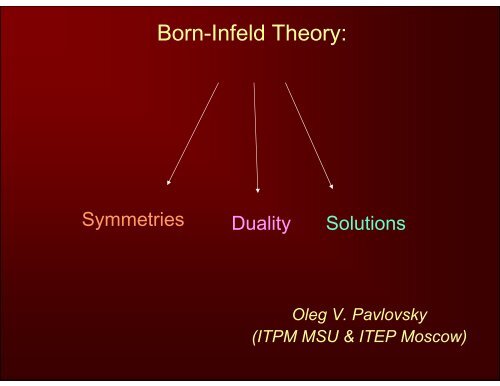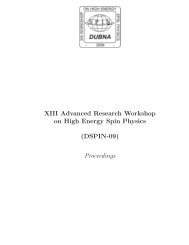Born-Infeld Theory:
Born-Infeld Theory:
Born-Infeld Theory:
You also want an ePaper? Increase the reach of your titles
YUMPU automatically turns print PDFs into web optimized ePapers that Google loves.
<strong>Born</strong>-<strong>Infeld</strong> <strong>Theory</strong>:<br />
Symmetries Duality Solutions<br />
Oleg V. Pavlovsky<br />
(ITPM MSU & ITEP Moscow)
• <strong>Born</strong>-<strong>Infeld</strong> <strong>Theory</strong>: general<br />
The theory that restricts its own field strength!<br />
By analogy with relativistic particle action<br />
It could be something like this<br />
L = C 1 −(<br />
X ) / C<br />
t<br />
2 2<br />
2<br />
L= β 1 −F<br />
/ β<br />
str
• <strong>Born</strong>-<strong>Infeld</strong> <strong>Theory</strong>: Electrodynamics (1934!!)<br />
Let us consider non-linear lagrangian<br />
In 4dim it could be rewritten as<br />
⎛ 2 1 2 1<br />
⎞<br />
− μν 4 μv<br />
2<br />
L= b ⎜1− 1 + b Fμν F − b ( Fμν F�<br />
⎜<br />
) ⎟<br />
2 16<br />
⎟<br />
⎝ ⎠<br />
If b tends to 0 we have Maxwell<br />
electrodynamics<br />
−2<br />
L = b (1− −det( g −bF<br />
)<br />
μν μν<br />
If field strength ~ b we have<br />
nonlinear regime
• <strong>Born</strong>-<strong>Infeld</strong> Electrodynamics: self-duality<br />
Canonically conjugate variables<br />
�<br />
H<br />
∂L<br />
=− �<br />
∂B<br />
�<br />
D<br />
Duality transformation<br />
∂L<br />
= �<br />
∂E<br />
� � � �<br />
D+ iB→ e<br />
iθ<br />
( D+ iB)<br />
� � � �<br />
iθ<br />
E + iH → e ( E + iH )<br />
Leads to highly non-trivial and non-linear constraint<br />
� � ��<br />
DH = EB
Electrodynamics (photonic) solitons = BI-ons<br />
If B=0, ( )<br />
−2<br />
2 2<br />
L = b 1− 1−b<br />
E<br />
Photonic solitons are very important for nonlinear optics. They pass<br />
through one another WITHOUT scattering!!!<br />
�<br />
The existence of a limiting<br />
field strength now finds<br />
dynamical (physical)<br />
justification in the<br />
increasing pairs<br />
production from vacuum<br />
Bachas&Porrotti<br />
PLB(1992)
Fields in Strong coupling regime<br />
Conformal symmetry<br />
<strong>Born</strong>-<strong>Infeld</strong> <strong>Theory</strong> and String <strong>Theory</strong><br />
Activity in<br />
<strong>Born</strong>-<strong>Infeld</strong><br />
Field<br />
<strong>Born</strong>-<strong>Infeld</strong> <strong>Theory</strong> as effective theory<br />
Critical phenomena at β → 0<br />
String-like objects
Scalar <strong>Born</strong>-<strong>Infeld</strong> theory in<br />
0+1 dim: integrability, “hidden” conformal symmetry<br />
and String <strong>Theory</strong><br />
1) Scalar BI theory in 1+1 dim = <strong>Theory</strong> of Bosonic String<br />
2 2<br />
L = 1− 1 −( ϕt − ϕx<br />
)<br />
⎛ t(,<br />
τσ)<br />
⎞<br />
μ ⎜ ⎟<br />
X =<br />
⎜<br />
x(,<br />
τσ)<br />
⎟<br />
⎜y= ϕ( t( τ, σ), x(<br />
τ, σ))<br />
⎟<br />
⎝ ⎠<br />
L =− ( XX � ′ ) −X�<br />
X ′<br />
2 2 2<br />
2) Weyl invariance (conformal symmetry) in the String language<br />
leads to the integral of motion in the BI theory
Conformal group symmetry of BI fields
“Quasi-elastic” scattering of BI solitons<br />
2 2<br />
(1 − ϕt ) ϕxx + 2 ϕϕ t xϕtx − (1 + ϕx ) ϕtt<br />
= 0<br />
ϕ =Φ ( x+ t)<br />
Two type of solitons:<br />
ϕ = Φ( x −t)
“Quasi-elastic” scattering:<br />
2 2<br />
1 − ( ϕt − ϕx<br />
) ><br />
0
Shock-free wave propagation in scalar BI<br />
theory<br />
Evaluation of “wave-fronts” by method of characteristics<br />
J. McCarthy & O. Sarioglu<br />
If characteristics are crossing each other = generation of shock-wave.<br />
If not = smooth initial condition leads to smoothness of global solution!
Scalar BI <strong>Theory</strong> – non-linear theory with<br />
L = L( ∂μϕ)<br />
no-shock wave propagation<br />
L = ( ∂μϕ)<br />
free<br />
2<br />
LL ' '''− 3( L'')<br />
= 0<br />
2<br />
L = 1− 1 −( ∂ ) μϕ<br />
BI<br />
2
φ<br />
Singular solutions of BI <strong>Theory</strong><br />
In BI theory singular solutions have finite energy!<br />
Typical example: “Catenoid” solution of scalar BI <strong>Theory</strong> in 4dim<br />
Catenoid is static spherically symmetrical solution,<br />
it looks like BI-on solution, but with singularity in its derivative<br />
at finite radius (so called “horizon” surface).<br />
BI − on<br />
() r = C<br />
∞<br />
∞<br />
dx<br />
dx<br />
∫ φcatenoid<br />
() r = C∫<br />
4 2<br />
4 2<br />
r x + C<br />
r x − C
Catenoid: prototype of “real” BI shock-waves<br />
But how to extend into forbidden region?<br />
Analyticity<br />
Physical considerations
Extension by Analyticity
Physical considerations: Heisenberg model of pion fireball<br />
production<br />
L = 1− 1 + b ( ∂ ϕ) +<br />
m ϕ<br />
H− BI<br />
2 2 2 2<br />
μ π
Heisenberg picture of the HE hadronic<br />
scattering (1952!!!)
Heisenberg picture of the HE hadronic<br />
scattering (1952!!!)
Fireball: analogy<br />
with atom-bomb<br />
explosion
<strong>Born</strong>-<strong>Infeld</strong> <strong>Theory</strong> for Mesons in 1+1 dim.<br />
Two scenarios of the HE scattering: “quasi-elastic”<br />
and “inelastic” (decreasing and increasing)
“Quasi-elastic” scenario:
“Inelastic” scenario:
“Expected” decreasing and “unexpected” increasing<br />
Unitarily in scattering<br />
at large S:<br />
σ s →∞ ∼<br />
2<br />
Log s<br />
Froissart ’ 1962
Motivation:<br />
<strong>Born</strong>-<strong>Infeld</strong> <strong>Theory</strong> and cosmology<br />
Many candidates for dark energy have been proposed so far to fit the<br />
current observations.<br />
The major difference among these models are that they predict different<br />
equation-of-state parameter w of the dark energy and thus different<br />
cosmology.<br />
Recent observations suggest a value w even less than −1!<br />
Indeed, they can lie in the range −1.38 < w < −0.82.<br />
Results from SN-Ia alone are suggesting w < −1 at 1 sigma!
Phantom fields and <strong>Born</strong>-<strong>Infeld</strong> fields<br />
Phantom fields are the fields with negative kinetic term.<br />
A matter with w < −1 has some strange physical properties:<br />
energy density might increases with time, might lead to the existence of<br />
astrophysical or cosmological wormhole and so on.<br />
We need appropriate and physically motivated model for phantoms!<br />
Tachyon fields of String <strong>Theory</strong>: Natural candidate on the role of phantoms!<br />
Qualitative dynamics of string theory depends of the models, but generally<br />
it must be <strong>Born</strong>-<strong>Infeld</strong> <strong>Theory</strong> with some potential<br />
μ<br />
L = V ( T) 1−∂<br />
T∂T effective<br />
μ
<strong>Born</strong>-<strong>Infeld</strong> Cosmology<br />
Felder, Kofman, Starobinsky (2002)<br />
J. G. Hao and X. Z. Li, (2003)<br />
…………………………………………<br />
R<br />
1<br />
= ∫ − + ∫ (1− 1 − ∂ ∂ − ( ))<br />
16π<br />
G b<br />
4 μ<br />
4<br />
S gd x b μT<br />
T V T d x<br />
In Robertson-Walker there are only two degrees of freedom would be<br />
interesting for us: the scale factor a(t) and scalar tachyon field T(t).<br />
3π1 = ∫ − �<br />
+ ∫ π − − � −<br />
4G<br />
b<br />
2 2 3 2<br />
S a(1 a ) dt 2 a (1 1 bT V ( T )) dt
<strong>Born</strong>-<strong>Infeld</strong> W<br />
Our aim is to calculate energy density and pressure of<br />
tachyon fields T<br />
0 1 1<br />
ρ T = T0= − + V<br />
b 1−<br />
bT b<br />
W<br />
T<br />
2<br />
t<br />
P<br />
bT<br />
= =− −<br />
ρ + − −<br />
2<br />
i 1 1−<br />
bTt<br />
PT = Ti = − −V<br />
b b<br />
T<br />
T<br />
1<br />
1 ( bV ( T )<br />
2<br />
t<br />
1) 1<br />
2<br />
bTt<br />
For any suitable choice of potential V(T) state parameter less than -1!!!<br />
Typically people used String motivated potential<br />
⎛ T ⎞ −<br />
To<br />
VT ( ) = V⎜1+ ⎟e<br />
0<br />
⎝ T0<br />
⎠<br />
T
Conclusions:<br />
<strong>Born</strong>-<strong>Infeld</strong> <strong>Theory</strong> is a very interesting object of Modern<br />
Mathematical Physics.<br />
It has absolutely unique properties that make this theory very<br />
attractive for various applications in different branches of<br />
physics.<br />
BI is used in: non-liner optics, condense matter physics,<br />
nuclear physics, high-energy physics, string theory and<br />
recently in Cosmology!<br />
BI cosmology is a hot-point now, a lot of interesting results<br />
waits!










